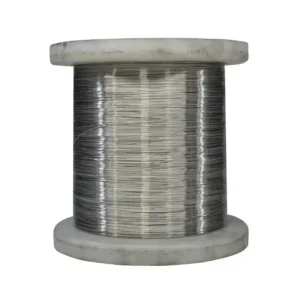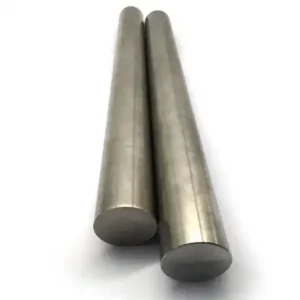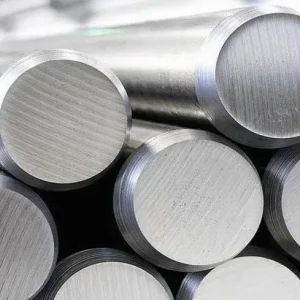Incoloy 800 wire (UNS N08800) is a nickel-iron-chromium alloy that combines good room temperature strength with excellent stability and resistance to oxidation and carburization at elevated temperatures, making it a reliable choice for furnace hardware, heat-treat baskets, radiant tubes, chemical processing components and other high-temperature service applications. When designers require superior carburization resistance plus service up to roughly 700°C, and when welding, forming and long-term dimensional stability matter, Incoloy 800 wire is a balanced, proven option.
1. Introduction and short recommendation
Incoloy 800 wire offers a strong combination of high-temperature oxidation resistance and general corrosion resistance while remaining ductile enough for wire drawing and forming operations. Product users who require stability after long exposure to temperatures in the range of 600 to 800°C will find the alloy particularly appropriate because it resists the formation of embrittling phases and tolerates carburizing atmospheres well. For parts that must retain dimensional integrity under cyclic thermal exposure, wire produced to N08800 specification is routinely used.
2. Alloy identity and official designations
-
Common trade name: Incoloy 800
-
UNS number: N08800
-
European W. Nr.: 1.4876 (commonly used in procurement documents)
-
Forms available: wire, strip, rod, tube, plate and sheet. Wire is normally supplied in coils, spools or straight lengths depending on customer needs.
3. Chemical composition (typical ranges)
The chemical balance gives Incoloy 800 its unique high-temperature stability. The table below shows the typical analysis ranges commonly specified for UNS N08800 material used to make wire. Exact limits must be confirmed with the supplier and material certificate for any given lot.
Table 1: Typical chemical composition of Incoloy 800
| Element | Typical range (wt%) |
|---|---|
| Nickel (Ni) | 30.0 – 35.0 |
| Chromium (Cr) | 19.0 – 23.0 |
| Iron (Fe) | Balance (approx. 38 – 46) |
| Carbon (C) | ≤ 0.10 |
| Manganese (Mn) | ≤ 1.0 |
| Silicon (Si) | ≤ 1.0 |
| Copper (Cu) | ≤ 0.75 |
| Aluminum (Al) | 0.15 – 0.60 |
| Titanium (Ti) | 0.15 – 0.60 |
| Sulfur (S) | ≤ 0.015 |
Notes: Supplier datasheets show small variations. For tight creep properties or for 800H/800HT variants, carbon and Al/Ti limits are controlled differently. Always source the manufacturer certificate to confirm composition for critical parts.
4. Microstructure and metallurgy why the chemistry matters
The alloy has an austenitic face-centered cubic matrix stabilized by the nickel content. Chromium provides oxidation and sulfidation resistance. Aluminum and titanium act as titanium and aluminum stabilizers that can form fine intermetallic precipitates under controlled heat treatment, which help control grain growth and influence creep resistance in the H and HT variants. Carbon is kept low in the base 800 grade to preserve ductility and avoid excessive precipitation of carbides at grain boundaries, which helps reduce the risk of intergranular embrittlement during long exposures.
Because the base chemistry avoids high ferrite-forming elements, the alloy retains a stable austenitic structure after long thermal exposure, yielding predictable mechanical behavior for wire that must be cold formed or drawn.
5. Mechanical properties and temperature limits
Mechanical properties vary with product form, cold work, heat treatment and test condition. Typical annealed-room-temperature baseline properties for wire-grade Incoloy 800 are shown in the table below. For high-temperature strength or creep-rupture data, use the manufacturer design bulletin and code allowable stresses.
Table 2: Representative mechanical properties (annealed condition)
| Property | Typical value |
|---|---|
| Density | 7.9 – 8.0 g/cm³ |
| Tensile strength (annealed) | ~480 – 620 MPa (varies with form and anneal) |
| Yield strength (0.2% offset) | ~170 – 300 MPa |
| Elongation (in 50 mm) | 30 – 50% |
| Hardness (HRB) | ~75 – 95 (varies) |
| Service temperature (recommended upper) | Continuous use up to ~700°C; short excursions higher with design caution |
For cyclic high temperature use or where creep is a design driver, consider the 800H/800HT family because controlled carbon and Al/Ti additions plus specific heat treatments increase creep-rupture strength significantly. Engineers should consult stress-rupture tables and vendor curves for sustained-load design.
6. High-temperature performance: oxidation, carburization and creep
-
Oxidation resistance: Chromium and nickel provide an oxide-forming balance that reduces mass gain in oxidizing atmospheres up to several hundred degrees Celsius. This protects surfaces in furnaces and heat treat equipment.
-
Carburization resistance: The alloy resists carburization better than many stainless steels thanks to the nickel-chromium ratio and controlled carbon content, which makes it suitable for tubes and liners in hydrocarbon cracking and petrochemical service.
-
Creep behavior: For high stress at elevated temperature, the 800H and 800HT variants provide higher creep-rupture strength because of controlled carbon and stabilizing element levels plus a high-temperature anneal. Use the 800 base alloy for moderate temperature stability and 800H/HT when creep is critical.
Engineers should select the grade and heat treatment based on time at temperature, applied stress and desired safety factor. When long-term creep limits matter, do not rely on room-temperature mechanical data; instead use certified creep-rupture curves from the alloy producer.
7. How Incoloy 800 differs from 800H and 800HT
The three alloys share a common base chemistry, but modifiers and tighter controls create distinct performance envelopes.
Table 3: Quick comparison: 800 versus 800H versus 800HT
| Feature | 800 (UNS N08800) | 800H (UNS N08810) | 800HT (UNS N08811) |
|---|---|---|---|
| Carbon control | ≤ 0.10, broad | 0.05 – 0.10 (tighter) | 0.06 – 0.10 (tight control) |
| Al + Ti | typical | controlled | tightly controlled |
| Primary use | general high-temperature service | higher creep strength | highest creep strength and dimensional stability at elevated temperatures |
| Heat treatment | anneal for ductility | high-temperature anneal to develop creep strength | specialized anneal with tight grain control |
For wire products, 800 is common for general furnace parts and heat-treat baskets. Where rupture or creep-resistance under prolonged thermal stress is mandatory, specify 800H or 800HT and require the appropriate mill certification and heat treatment record.
8. Standards, specifications and typical wire designations
Wire produced from Incoloy 800 is commonly manufactured and tested to several international and aerospace specifications. Typical references and standards for wire include:
-
ASTM B408: Standard specification covering wrought nickel and nickel-base alloy wire.
-
AMS 5766: Aerospace material specification for certain nickel-chromium-iron alloys in wire form.
-
ISO 9723 / ISO 9724: International wire standards used in some markets.
-
Welding filler metals: AWS classifications useful for repair and joining include ENiCrFe-2 variants and ERNiCr-3 depending on filler selection.
Supply contracts should request mill test reports to confirm adherence to the named standards and any customer-specific acceptance tests.
9. Forms, manufacturing and typical wire dimensions
Incoloy 800 wire is produced by hot-rolling billet into rod, followed by multi-stage cold drawing to required diameters. Processes and finishes include bright draw, shot blasting, and pickle passivation depending on end use.
Table 4: Typical wire offerings and packaging
| Diameter range | Typical supply form | Packaging |
|---|---|---|
| 0.10 mm to 0.50 mm | ultra-fine bright wire | spools, small coils |
| 0.5 mm to 6.0 mm | general purpose wire | coils, spools, straight lengths |
| 6.0 mm to 12 mm | heavy diameter wire / rod | coils, straight cut bars |
| >12 mm | supplied as bar/rod rather than coil | straight lengths |
Packaging varies by diameter and customer: coils for feeding into automated equipment, spools for small-diameter wire, and protective wraps with desiccant for long storage.
10. Fabrication: cold working, drawing, annealing and welding
-
Cold drawing: Incoloy 800 draws well because the alloy retains ductility. Sequence drawing with intermediate anneals yields tight dimensional control and improved surface finish.
-
Annealing: Final anneal treatments relieve drawing stresses and restore ductility. Typical anneal cycles are defined by suppliers; for wire, a bright anneal in controlled atmosphere is common.
-
Welding: GMAW, GTAW and specialized filler metals are used for joining. Match filler to service: when corrosion resistance and elevated temperature strength are required, select a nickel-chromium-iron filler compatible with N08800 family. Preheat is normally not required, but post weld heat treatment may be specified for certain components. Consult welding procedure specifications and the filler metal datasheets.
11. Quality control, acceptance tests and traceability
For critical applications purchase orders should specify:
-
Mill test certificate (chemical and mechanical results) traceable to the heat lot.
-
Hardness and tensile test results for wire batch samples.
-
Non-destructive inspection where needed for surface defects.
-
Microstructural examination and grain size data when 800H/HT is specified for creep service.
-
Supply-chain traceability and batch marking for safety-critical components.
Independent verification testing in a qualified lab is recommended for life-critical equipment.
12. Typical applications and industry examples
Incoloy 800 wire and wire-derived parts are widely used in sectors such as:
-
Heat-treatment equipment: muffles, baskets and hangers because the alloy resists oxidation and carburization at high temperature.
-
Petrochemical furnaces and cracking equipment: components exposed to hydrocarbons and high temperature.
-
Aerospace and power generation: in specialized high-temperature hardware where stable microstructure matters.
-
Nuclear and processing plants: selected for high-temperature stability and predictable aging response.
These uses reflect the alloy's combination of oxidation resistance and dimensional stability under thermal cycling.
13. Handling, storage and packaging recommendations
-
Store in a clean, dry environment to avoid surface contamination.
-
Use non-reactive separators and packaging to prevent scoring during transport.
-
For long-term storage include desiccant and consider inert atmosphere packing for ultra-clean wire intended for vacuum or high-purity applications.
-
Inspect surface prior to forming operations; small surface defects in wire can become initiation sites for failure under cyclic stress.
14. Design and selection checklist for engineers
When specifying Incoloy 800 wire, include:
-
UNS number and exact alloy variant (N08800 or N08810/N08811 when needed).
-
Required mechanical property minimums and test certificates.
-
Operating temperature range and duration for transformation to determine if a creep alloy is required.
-
Environmental exposure: oxidizing, carburizing, chlorides, cyclic oxidation.
-
Surface finish and packaging requirements.
-
Welding/filler metal compatibility.
-
Traceability and acceptance tests.
Providing these details on the purchase order prevents later misunderstandings and ensures the supplier provides wire with the correct processing history and certification.
15. Environmental, health and safety (EHS) notes
-
Machining or grinding creates metal dust that must be controlled via local extraction and proper PPE.
-
High-temperature oxidation products can be irritants; for processes that generate fumes use adequate ventilation.
-
Always consult the supplier safety data sheet for handling, cutting and waste disposal guidance.
16. Relevant tables and quick reference
Table 5: Standards quick reference for wire production and acceptance
| Application | Common standard or spec |
|---|---|
| General wire manufacturing | ASTM B408. |
| Aerospace wire specifications | AMS 5766. |
| Datasheets and technical bulletins | Special Metals technical bulletin for INCOLOY 800. |
| Material property summary | MatWeb datasheet for INCOLOY 800. |
| Industry articles and application notes | AZoM Incoloy 800 article. |
17. Procurement tips and vendor questions
When approaching suppliers ask for:
-
Current mill heat number certificate listing full chemical analysis and mechanical test results.
-
Declaration of conformity to the requested standard.
-
Surface finish and packaging options.
-
Lead time and lot splitting options for production runs.
-
Reference list of previous deliveries for similar applications if the purchase is critical.
18. Frequently asked questions
Q1: What is the difference between Incoloy 800 wire and stainless steel wire for high-temperature use?
A: Incoloy 800 contains much higher nickel content and a specific nickel-chromium balance that provides superior carburization resistance and a more stable austenitic structure at high temperature when compared with typical stainless steels. For carburizing atmospheres and where sigma-phase embrittlement risk exists, Incoloy 800 is often preferred.
Q2: Can Incoloy 800 wire be bent and formed without intermediate anneal?
A: Small cold work bends are possible but multiple passes or tight-radius forming usually require intermediate anneal steps to restore ductility. Confirm the forming schedule with the material supplier.
Q3: Is Incoloy 800 weldable and what filler is recommended?
A: Yes, it is weldable using appropriate nickel-based fillers such as ERNiCr-3 or ENiCrFe-2 types. Welding parameters and filler selection depend on the intended service temperature and corrosion exposure.
Q4: For continuous service at 750°C which variant should I choose?
A: For long-term stressed service at or above 700°C choose 800H or 800HT. Those variants are processed to provide higher creep strength. Request the specific allowable stress tables from the mill.
Q5: What acceptance tests do customers typically require for wire?
A: Typical tests include chemical analysis, tensile test, hardness test, and visual/UT surface inspection for critical runs. For creep-critical parts require creep-rupture data or proof of supplying to 800H/HT with grain size cert.
Q6: Does Incoloy 800 form sigma phase in long service?
A: The composition and nickel level make the alloy less prone to sigma phase formation than many high-chromium steels. Proper control of composition and heat treatment reduces this risk further.
Q7: What wire diameters are available from stock?
A: Standard stock ranges vary by supplier. Many mills offer 0.5 mm to 6 mm from stock, with custom draws available for finer or heavier sections. Check supplier catalogues for exact inventory.
Q8: Is pickling required before supply?
A: Bright anneal and controlled surface treatments are common for wire designed for high-purity or vacuum applications. Furnish surface finish requirements on the order.
Q9: How does Incoloy 800 respond to thermal cycling?
A: It shows good dimensional and microstructural stability under many cycles, making it suited for heating element supports and furnace baskets. For severe cyclic stresses evaluate fatigue and thermal-shock data with the material supplier.
Q10: Where can I find authoritative design data and material bulletins?
A: Primary sources include the alloy producer technical bulletins, recognized materials databases, and peer-reviewed engineering handbooks. Obtain PDFs and certified test data from the mill or authorized distributor.
19. Closing notes for technical buyers and engineers
Incoloy 800 wire is a mature, documented material with broad industrial adoption. To gain full benefit specify the correct UNS designation, request mill certification, and choose the 800H or 800HT variant if creep performance is a requirement. When in doubt run a service simulation or accelerated aging test on samples from the intended production lot.





